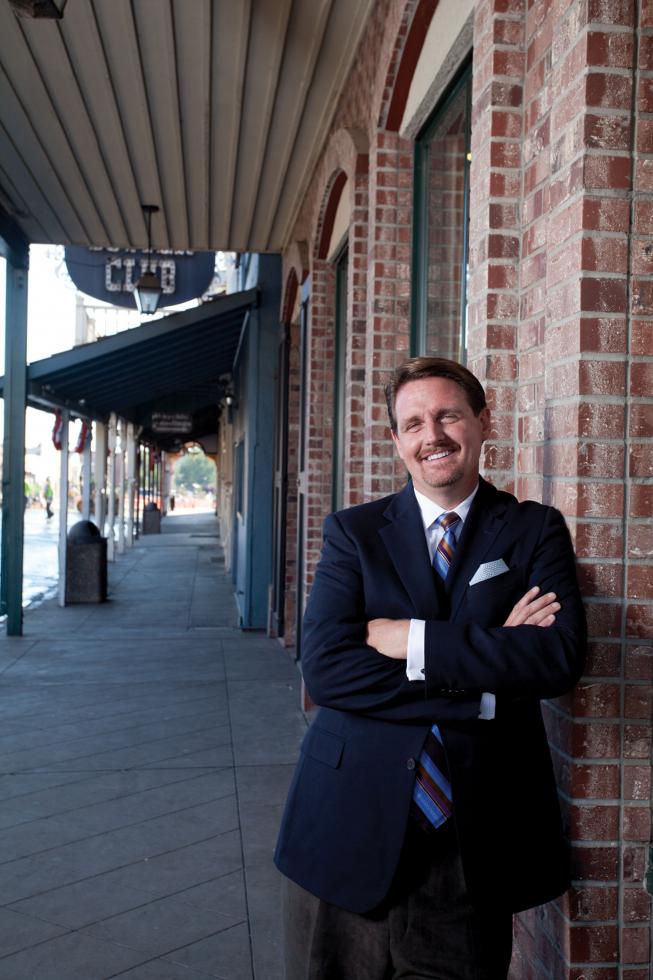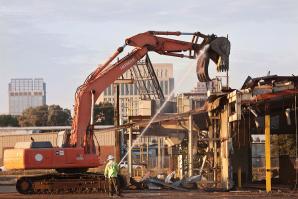John Lambeth, president, Civitas Inc.

California is used to being the trendsetter. The state has led the way on everything from auto emissions standards to stem cell research, but when Assembly Bill 3754 was signed into law in 1994, California was the 40th state to allow the creation of Property and Business Improvement Districts.
PBIDs are property tax assessment districts created and approved by the property owners who pay the tax and benefit from its revenue. PBIDs have been used throughout the country to finance economic development, maintenance, security and other services crucial to the vitality and economic well-being of urban centers. And while California was late to the PBID party, the idea caught on quickly. Since the launch of the state’s first PBID in 1996, the Downtown Sacramento Partnership, more than 175 of these districts have been created, including 20 in the Capital Region.
Only one thing makes them so popular: they work. What makes them work, however, varies. At minimum, these districts need a working partnership between public and private sectors, a spirit of cooperation among competitors and a little bit of cat herding. And that’s just to get them off the ground.
The opening paragraphs of AB 3754 didn’t paint a pretty picture. To quote the legislative findings: “Businesses located and operating within the business districts of this state’s communities are economically disadvantaged, are underutilized and are unable to attract customers due to inadequate facilities, services and activities in the business districts.”
Downtown Sacramento was a poster child for the chronic problems facing urban centers everywhere. Blight, crime, vagrancy and panhandling made downtown an unpleasant place even in daylight. There was little to no marketing of downtown as a destination, and limited public funds could only do so much to address the problems.
In Sacramento, like elsewhere, the redevelopment agency was pushed into the central role of improving downtown, but options were limited.
“Redevelopment can only address the physical conditions and try to make improvements in appearance and infrastructure. Beyond that, redevelopment funds can’t really be used,” says John Shirey, executive director of the California Redevelopment Association. “Back then, if you wanted to take the next step and add services, like marketing or security, there was no real way to do that.”
At the time, the only real tool available was a 1965 state law enabling the formation of Business Improvement Districts. Many downtown areas had them in 1994, but they were insufficient for the challenges.
“In the original BIDs, businesses paid a percentage of sales into the kitty, but they didn’t typically raise a lot of money,” says Craig Smith, president-elect of the California Downtown Association. “In some cases, participation was even voluntary. You can guess what kind of resources those groups had.”
If the downtown business community was going to find a way to thrive, it required a mechanism that would complement the work of the redevelopment staff and give the business and property owners better control over their collective destinies.
John Lambeth was, at the time, representing a small group of property owners in downtown Sacramento that had come together to find that mechanism. He started looking across the country to see what other downtown organizations had done.
“We found a common model of property owner-led organizations funded through owner assessments,” Lambeth says. “With some cherry-â?¨picking, we were able to craft legislation that made the most sense for California.”
The proposal garnered plenty of support from statewide groups like the League of California Cities and a host of individual cities and downtown business associations with only one major opponent, the Howard Jarvis Taxpayers Association. In the end, the bill made it through the Legislature on its first try, in part from efforts to build support and in part from Louis Caldera, who carried the bill and guided it through the political maze.
“We had a real champion in Assemblyman Caldera,” Lambeth says. “He believed in what we were doing. To this day he says this is the most significant piece of legislation he’s worked on.”
Once PBIDs became an option, their popularity grew quickly, primarily because of the results they could generate in terms of revenue. Downtown business associations that had been accustomed to annual budgets of maybe a hundred thousand dollars suddenly had closer to $1 million or more in their first year.
At the same time, the law included a provision for a Baseline Services Agreement between the PBID and local government. The BSA is an agreement between a city and county not to reduce the level of services in the district area, despite the fact that the district is raising money to provide some services on its own. It’s a measure of protection against municipalities diverting funds for basic services to another area because they see the funding as redundant.
Even more enticing, the commitment on the part of property owners has been successfully used to attract substantial sums of money from public and private sources. Some of the more successful PBIDs have leveraged $25 million or more to support streetscaping and infrastructure improvements, for example, while savvy developers have hoisted the PBID to attract private investment.
In Sacramento, developer David Taylor, who served as the first chairman of the Downtown Sacramento Partnership, credits the PBID for helping change the Sacramento skyline.
“Without the PBID and the political structure of the city behind it, it would be much more difficult to get private investors to put up the kind of money necessary for the size and scope of some of the projects we’ve done,” says Taylor, with David S. Taylor Interests Inc. “Since the (Downtown Sacramento Partnership) PBID was formed in 1996, we’ve gotten more than $400 million in private capital invested in the region.”
Even with those outcomes, convincing property owners to tax themselves is not an easy prospect, even in the best economy. The law requires property owners representing at least 50 percent of the total value of the assessed district submit petitions in support of the district before formation can begin. It’s not uncommon for property owners to ask why they should pay more out of their own pockets when they already pay taxes, presumably for the kind of services PBIDs provide.
“There are so many needs, and only so many dollars to go around,” says Sacramento City Councilwoman Bonnie Pannell, who serves on the board of the Florin Road Partnership. “Making this kind of commitment in PBIDs gives owners much more control over their own future. What these districts do not only complements what the city does, it helps us improve the city overall.”
The California Downtown Association has developed an 11-page manual, “The ABCs of California BIDs,” which includes a road map to forming a district. All 12 steps are essential for PBIDs, but some are more essential than others.
“The most important part of the process is consensus building among the partners,” Lambeth says. “You have to reach out to owners, ask them what they’d like to see in a district and listen closely to how they respond. Show them a draft document, make sure you’ve got it right and only then should you even start the petitioning process.”
The importance of good two-way communication only grows after the PBID launches. Inherent in the law is language that requires PBIDs disband automatically after five (or in some cases 10) years unless the property owners vote to renew. The most successful PBIDs constantly assess which services owners value, which ones they don’t and whether additional services should be added as the district evolves. If owners don’t see or appreciate that value, they won’t vote to renew the district.
The most important relationships PBIDs have are with the staff, at all levels, of the local city and county government. PBIDs are, by definition, public/private partnerships wherein tax assessments are collected under the authority of the local government. The most effective PBIDs have worked to ensure the services they provide to their members complement rather than duplicate or replace city services.
All said, there are times when PBIDs aren’t a solution.
“We’re talking about selling services,” Lambeth says. “When there’s not a set of services owners can agree they need, it’s ultimately not going to work.”
Of California’s roughly 175 operating PBIDs, Lambeth estimates the renewal rate is somewhere around 95 percent.
He’s arguably the best person to make that estimate. His company has been at the helm of 100 PBID formations in the U.S. and abroad. “We don’t look to just set these up and move on; each one we start is like a new little entity we watch closely,” he says. “I’m so proud of the work these districts have done to make their communities better and how well they’ve worked overall.”
Local elected officials, community associations and statewide associations throughout California also have plenty of praise for PBIDs and the benefits they bring.
“We think this has been a good law for local communities as well as the state,” says Patrick Whitnell, general counsel with the League of California Cities. “The services they provide ultimately work to increase business revenues, which increases tax revenues for the local government, which means more benefits for the broader community.”
Smith, of the California Downtown Association, agrees.
“Downtowns were dying years ago. PBIDs have helped bring them back, and people should remember that we’re not just talking about shopping districts,” he says. “Downtowns are the civic centers of a community. You won’t see the kind of arts, music, culture and government in a mall that you see in a downtown district, so keeping them healthy is vital.”
Looking back, while he recognizes the law he helped create has “improved” with a handful of amendments over the years, Lambeth says California essentially got it right. Asked if he’d do anything differently, he says no, but in hindsight he’s seen some things that he and the bill’s other original champions just didn’t consider.
“One thing I didn’t think about at first is how to strike the balance between public and private,” he says. “We have one foot on each side of that line, but I think we did it just right. If we’d set these up to be run as just another department in a municipal government, I don’t think we’d have any PBIDs in California.”
With the economy being what it is and cities throughout the state teetering on the edge of bankruptcy, it’s a safe prediction that the growth of PBIDs will only continue. As belts tighten and sales decline, it’s harder to ask business owners for money, but as cities are forced to reduce services, PBID formation can stave off a return to the slow downward spiral in which many California urban centers were trapped in the early 1990s.
Lambeth says that even at their most basic level, PBIDs provide at least one benefit that simply can’t be measured.
“Even if you peel away everything else, the real story is that with PBIDs you have a majority of business and property owners, along with city and county government representatives, sitting around a table strategizing on what their downtown should be five years in the future,” he says. “The benefits of that just can’t be overstated.”
Recommended For You

Old Town, New Challenges
Acuity with Downtown Sacramento Partnership's Janie Desmond Ison
Janie Desmond Ison, 54, is the 2014 board chair of the Downtown Sacramento Partnership. She also has more than 20 years of involvement with the Old Sacramento Business Association.

Here Comes the Neighborhood
Area infill projects forge ahead
If everything goes as planned, the newest phase of the K Street redevelopment effort will open for business late next month off 10th Street, bringing a pizza place, dance club and “dive bar” stocked with costumed mermaids and mermen to the downtown mix.


